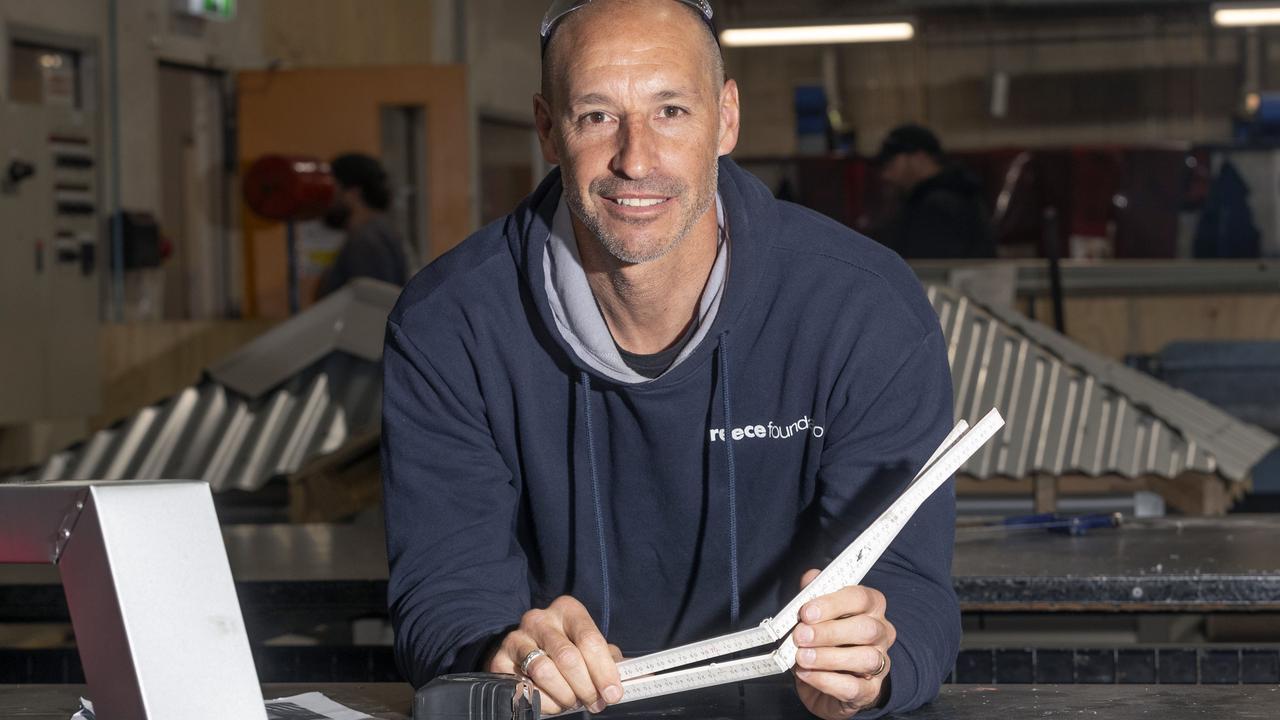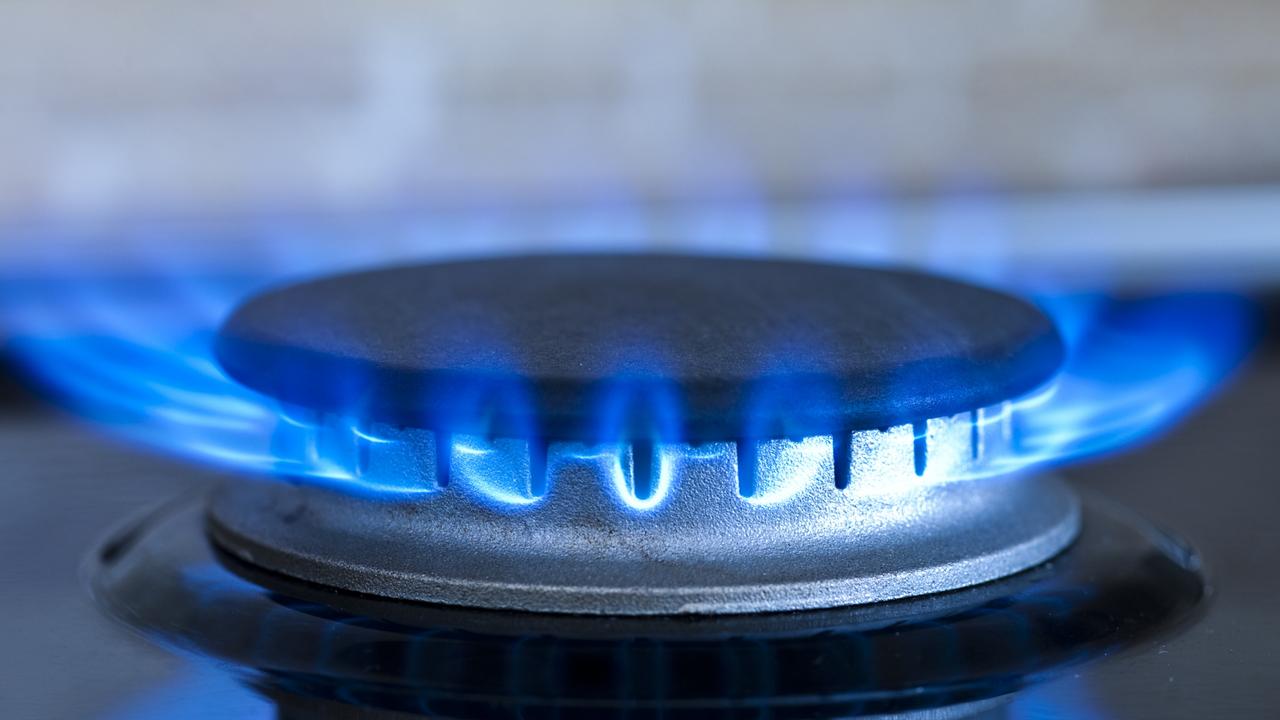Veterans recall dark days of war and your Anzac Day service guide.
When Allan Godfrey, 99, returned from war he couldn’t bear Anzac Day while for 95-year old veteran Alex Phillpotts the day still brings up memories of living dangerously.
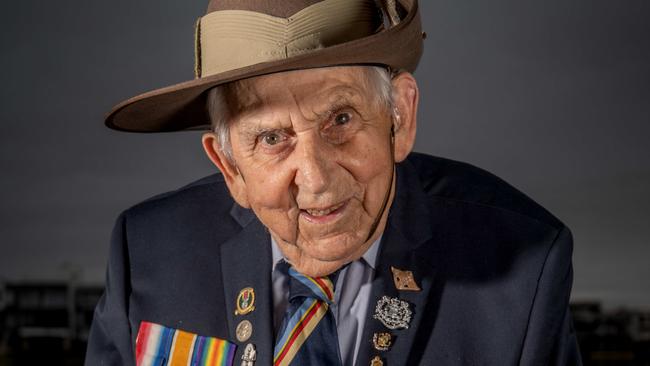
Victoria
Don't miss out on the headlines from Victoria. Followed categories will be added to My News.
When Allan Godfrey enlisted, he trained to fire a gun. But he was left-handed. He couldn’t pull the bolt of a .303 rifle.
He was transferred to the Light Horse. But he had never ridden a horse.
He was sent to drive a tank – yes, that’s right, he hadn’t driven a tank before.
“If someone was not supposed to go to war, it was Allan,” says his friend, Wendy Mason.
“If anyone was to survive the war, I wouldn’t have bet on Allan.”
Yet Godfrey wanted to go. At 17, as a bootmaker, he sought pursuits beyond post Depression-era Fitzroy, where he recalls that Collingwood fans would maraud after a football loss.
Yet his enlistment was foiled by his father, a World War I veteran who never talked about his experiences with his four kids.
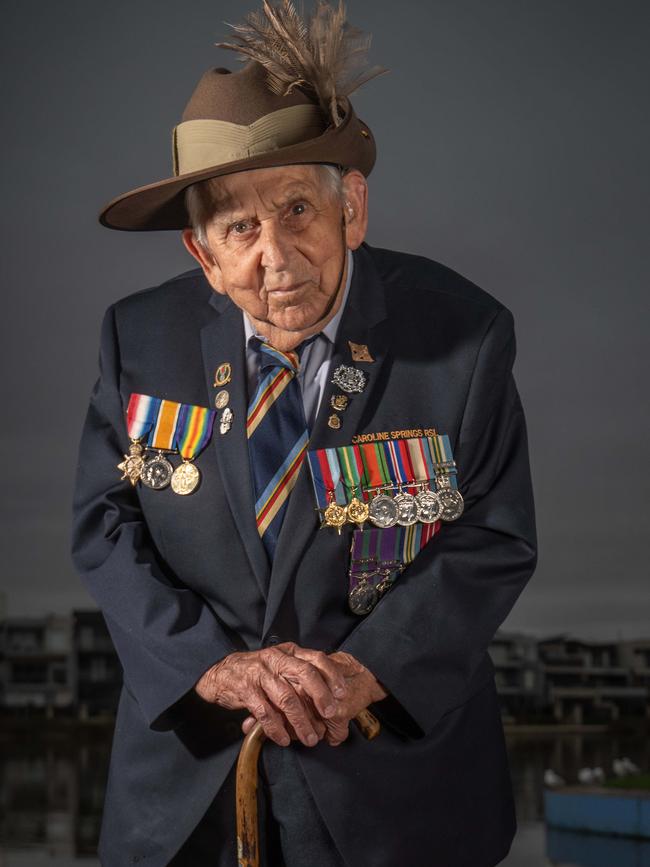
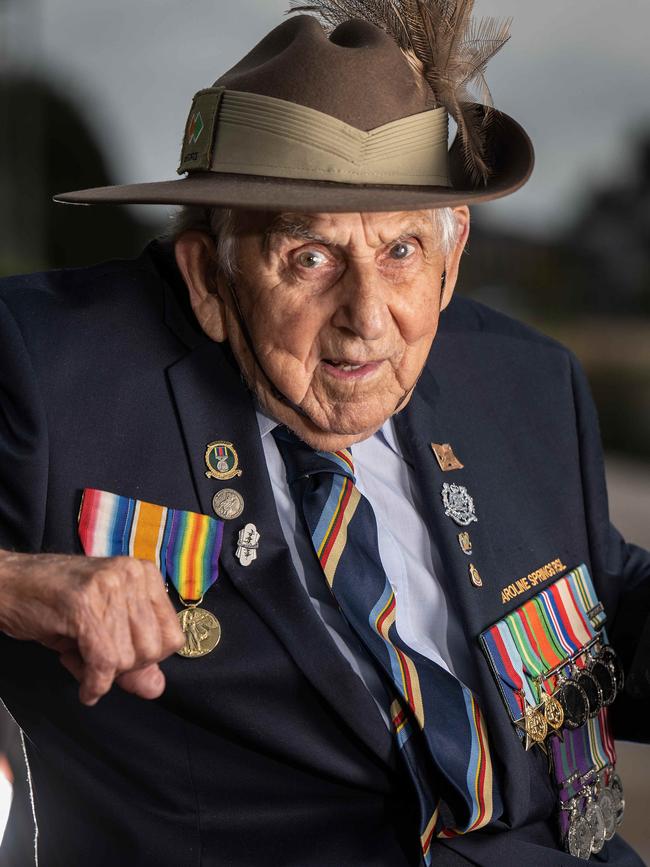
Percy Godfrey turned up at Collingwood Town Hall, “belted” his son, and dragged him home.
At 18, Godfrey tried again, successfully.
He spent the next six years being scared, seeing horrors he could not shrug off, and losing his dearest mates.
Thankfully, he was spared infantry service, and instead drove the wounded on jeeps from the frontlines to ships and airstrips.
That was his smartest move, he says, with a smile. At least in saving soldiers rather than fighting the enemy, you had some chance of surviving.
Today, his gnarled fingers clutch a beer as he speaks softly. Rows of medals shine under the emu feather of his Light Horse slouch hat.
Godfrey is sitting in dignified solitude at the WestWaters Complex in Caroline Springs, a hint of mischief twinkling in his eyes.
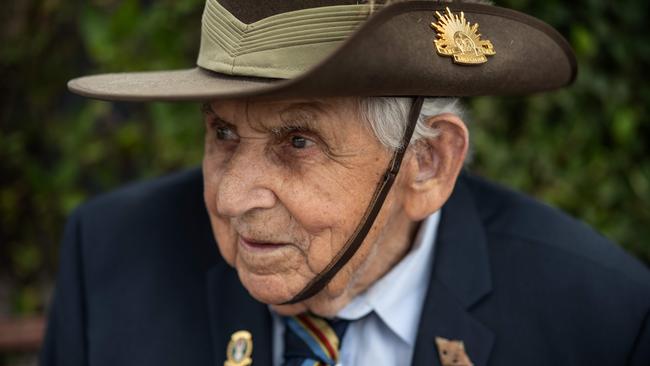
“Do you reckon I’ll make it?” he asks of triple figures.
At 99, despite a broken hip, he still insists on walking himself. He lives in St Albans with two great grandchildren. His sight and hearing have faded, and the police turned up at the door about a decade ago to revoke his driver’s licence.
His memory dims, here and there, as he speaks of fear and trauma, the comradeship of patriotism, and the futility of war.
He may confuse names. But Godfrey doesn’t forget how war changed a kid “who was only 18”, a boy “who didn’t know nothing”.
Godfrey is one of the last. They will all be gone soon. More than 700,000 Australians enlisted in World War II. Perhaps a few thousand are still with us, the youngest at about 95.
They are our last living link to this history, when 22,000 Australians were captured as prisoners of the Japanese, and the local fear of invasion was contagious.
Only a few souls can still describe the smells and the grief and, most of all for Godfrey, the abiding fear of the Japanese and those samurai swords.
Godfrey served across Asia, including hot spots such as Milne Bay, Malaya and Balikpapan. Those years are reduced to impressions now, such as the snipers lurking on slippery roads. Many of the scrambled details have faded, except for those moments he has tried and failed to forget.
In Darwin, he drove a tank, the only member of his team small enough to get in to steer. The tanks were poor quality, so hot you could fry an egg on their hulls.
Japanese soldiers were said to be spotted on the banks of the Daly River. He had heard that their swords would take an arm or a head in one swing. The soldiers did not materialise, to Godfrey’s relief, and the story goes that the crocs got them.
He recalls a paratrooper mission to land behind Japanese lines, to liberate prisoners of war. In Borneo he feared the gorillas, which could be heard nearby and were known to attack.
Near a pit of bodies, while seeking wounded, Godfrey spotted a flapping book near a dead Japanese soldier. It was opened to a family photo, of a wife and two children. Godfrey realised then, that the enemy “was just like us”.
He would smear mud on the Red Cross signage on his jeep to confuse the snipers. He wore an American helmet, which was much sturdier than the standard issue Australian (British) helmets.
He saw men blown in two, soldiers souvenir enemy body parts, heard tales of cannibalism, and feared proximity with any Japanese soldier, lest they blew up themselves (and anyone nearby) with hidden grenades.
Godfrey grew close to a fellow soldier he remembers as Ralph, a tall indigenous man originally from the Murray River country. Ralph’s death, perhaps in the last Big Australian ground mission, at Borneo’s Balikpapan, still affects Godfrey.
It seems that Godfrey had to retrieve Ralph’s body after he was shot by a sniper.
After the war, he went to Ralph’s mother’s Melbourne home, near Pentridge Prison, in Bell St. When he reached the gate, he couldn’t go in.
She had lost her only son. He didn’t know what to say.
Godfrey returned twice more, but could not pass the gate.
On returning from war, Godfrey gave out coins to kids as he delivered milk with a horse and cart early each morning.
He married Thelma and had three daughters, with whom he did not speak of his wartime service – indeed, he has spoken more freely on school visits than with family members.
Godfrey is a lay scholar of Australians at war. He wonders why Australia fought in some many faraway lands.
He marvels at the casualty-free evacuation of Gallipoli in 1915, and has lobbied for greater recognition for Balikpapan (where 16 of his mates are buried), which some argue was more significant than that other amphibious landing, Gallipoli, three decades earlier.
Godfrey laments the protests against returning Vietnam soldiers.
“It was wrong, they fought for our country,” he says.
Yet his desire for commemoration wasn’t always so strong. On his return, amid sleeplessness and flashbacks, he couldn’t bear Anzac Day. He avoided services. They hurt too much.
The Anzac Day service, for which he wears both his own and his father’s medals, has since been an annual ritual for about 70 years.
But it still hurts.
“It never leaves you, I could cry now,” Godfrey says over his beer.
“When they put the flag up, on Anzac Day, I’ll cry. It brings back the memories.”
BIG CROWD EXPECTED AT SERVICE AFTER TWO-YEAR HIATUS
Up to 30,000 people are expected to flock to Melbourne’s Shrine of Remembrance to honour the fallen in the biggest Anzac Day dawn service crowd since the coronavirus pandemic.
The traditional dawn service, followed by the march along St Kilda Rd, returns on Monday with no limits or restrictions on those attending for the first time in three years.
Just 1400 people were able to attend last year’s service – down from about 25,000 in 2019.
And in 2020 when the first lockdown was in place, people were forced to gather in their driveways, on balconies or at their front gates for the “Light up the Dawn” initiative.
RSL Victoria president Robert Webster OAM said this year’s Anzac Day will be particularly meaningful after the two-year hiatus.
“I think it’ll be a great community gathering, not only in Melbourne but across the state,” Mr Webster said.
“People will come out from across the state.”
He said nothing beats the in-person experience, waking up early and standing in the cold with family and friends to hear the last post play and pay your respects.
The service will be followed by the annual march, which will be lead by Vietnam War veterans Gary Taylor, Peter Liefman, and David Grierson from 8.30am.
This year marks the 60th anniversary of when Australian forces joined the Vietnam War and also 80 years since the Kokoda Track campaign in Papua New Guinea.
Mr Webster, announcing the march leaders at the Shrine on Saturday, said he was pleased the men would receive further recognition for their contribution to Australia.
“At various stages each of us, me included, served in Vietnam, and of course (it is) the 60th anniversary of the commencement of operations in Vietnam,” Mr Webster said.
“We thought it was appropriate this year that we would lead the march with three Vietnam veterans.”
Mr Taylor, a Navy veteran, expressed his privilege.
“I used to come here as a young boy back in the 50s and watch the service marching down to the Shrine, and here I am as one of the leaders — it’s quite an honour,” he said.
“I’m very privileged and honoured ... especially representing my former shipmates.”
This year’s dawn service starts at 5.30am, followed by the parade from 8.30am, which starts on Princes Bridge near Federation Square, and marches to the Shrine.
The service will be live-streamed on the RSL Victoria Facebook page.
Services will also be held at dozens of RSLs and cenotaphs around the state.
Pre-dawn train services will run on all metropolitan rail lines and extra trams are also scheduled for St Kilda Rd.
Later in the day, 24 more train services will run so footy fans can attend both the Anzac Day clash between Essendon and Collingwood at the MCG, and the NRL match at AAMI Stadium between Melbourne Storm and New Zealand Warriors.
Mr Webster urged people to visit rslvic.com.au to plan their Anzac Day.
TIMING FOR ANZAC DAY IN MELBOURNE
Monday April 25
5.30am-6.30am: Dawn Service begins at the Shrine of Remembrance
6.30am: Shrine of Remembrance opens to the public on conclusion of service
8.30am-12 noon: Vehicles carrying older veterans or those with disabilities will kick off the traditional parade at 8.30am, before marchers will move from Princes Bridge to the Shrine from 9am. A commemorative service will be held at the conclusion of the march.
10.56am: A Royal Australian Air Force PC-21 to do a fly over the Shrine.
3.20pm – A crowd of about 90,000 people is expected at the MCG for the traditional Easter Monday Essendon-Collingwood showdown
Sunday April 24
4pm- Anzac Day church service at St Paul’s Cathedral
Day of memories can stoke the emotions
By Mitch Ryan
For 95-year old veteran Alex Phillpotts, ANZAC DAY brings up memories of sailing the seas and living dangerously.
He joined the navy two years into the Second World War and sailed across the Pacific on an Australian army vessel holding almost 100 people on-board.
The crew would only ever leave the boat to refuel during their perilous journey on the seas. As a stoker, Mr Phillpotts played a vital role in ensuring operations on the coal-fuelled ship were running smoothly.
“I was down in the room that turned the turbines, running the boiler to keep the ship moving,” Mr Phillpotts recalls.
“We went to Japan and back to Sydney and back that way up the Pacific again.
“Most of the people I served with came from all across Australia.”
Despite sailing close to enemy shores, the Melbourne army vet managed to avoid direct conflict during the war.
“I was lucky - but a lot of people have suffered and were affected from their time during the war,” the veteran said.
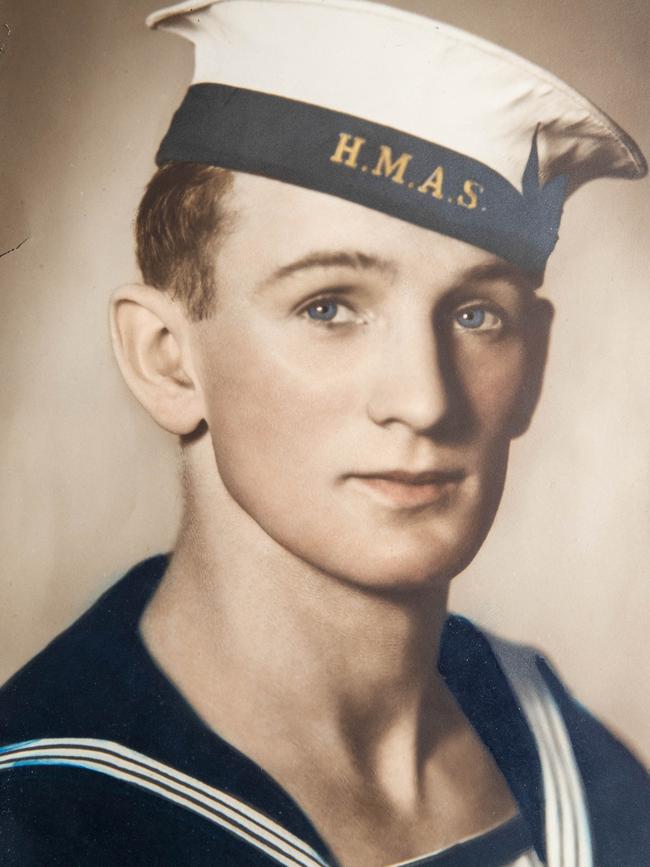
It’s why the serviceman is urging Victorians to dig deep to support this year’s ANZAC Appeal.
The money raised from the appeal will go towards supporting the welfare needs of current and former servicemen and women.
“[It will] enable us to deliver much needed assistance to those men and women who have served our country and who now need our support,” RSL Victoria’s Appeals Manager Peter Smith said.
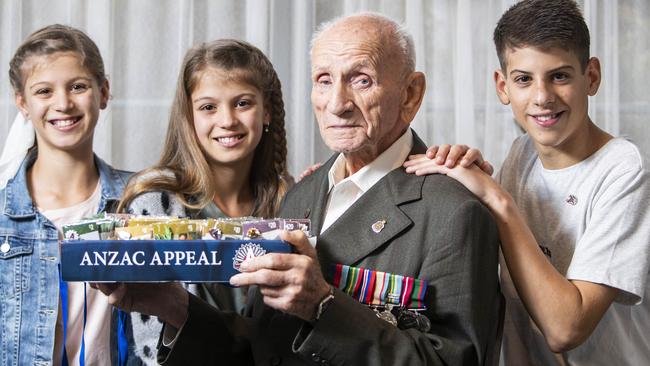
Mr Phillpotts, who is spending ANZAC DAY at a Bentleigh service with his four great-grandchildren, added April 25 will continue to remain an important day for veterans.
“You run into men you haven’t seen after all these years,” he said.
“Everyone just comes together.”
Donations can be made at anzacappeal.com.au
More Coverage
Originally published as Veterans recall dark days of war and your Anzac Day service guide.



